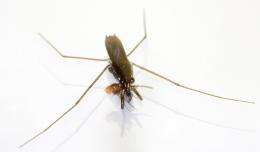(PhysOrg.com) -- Water striders, the familiar semi-aquatic bugs gliding across the lake at the cottage, have a novel body form that allows them to walk on water. This was not always the case. Achieving the gliding ability required the evolution of a unique arrangement of the legs, with the mid-legs greatly elongated. Scientists at the University of Toronto's Department of Ecology and Evolutionary Biology have discovered the gene behind this evolutionary change.
Called the Hox gene, Ultrabithorax, is known to play a role in lengthening legs in other insects. Professor Locke Rowe and his team investigated where Ultrabithorax is expressed and how it functions in the water strider body plan using the cutting edge tools of molecular biology. "To our surprise, we discovered that Ultrabithorax performs opposite functions in different limbs," says Rowe. "It lengthens the mid-legs but shortens the hind-legs to establish this unusual body plan that allows water striders to glide on the water surface."
Groups of organisms are characterized by a few defining characteristics. In the case of humans it is walking upright and in the case of spiders it is eight legs. It is these defining characteristics that account for much of the diversity we see in life. Determining how these major evolutionary changes happen is a central goal of evolutionary biology, explains Rowe. "Many have marveled at the ability of water striders to walk on water, and we are excited to have discovered the gene that has affected this evolutionary change."
The work is published in PLoS Genetics.
Source: University of Toronto (news : web)





















